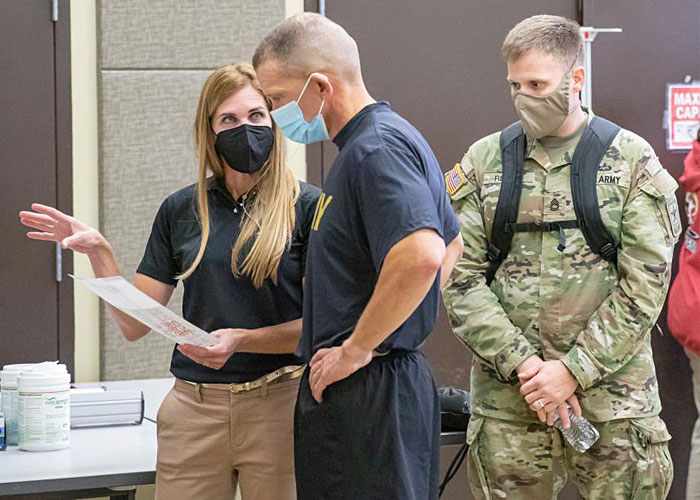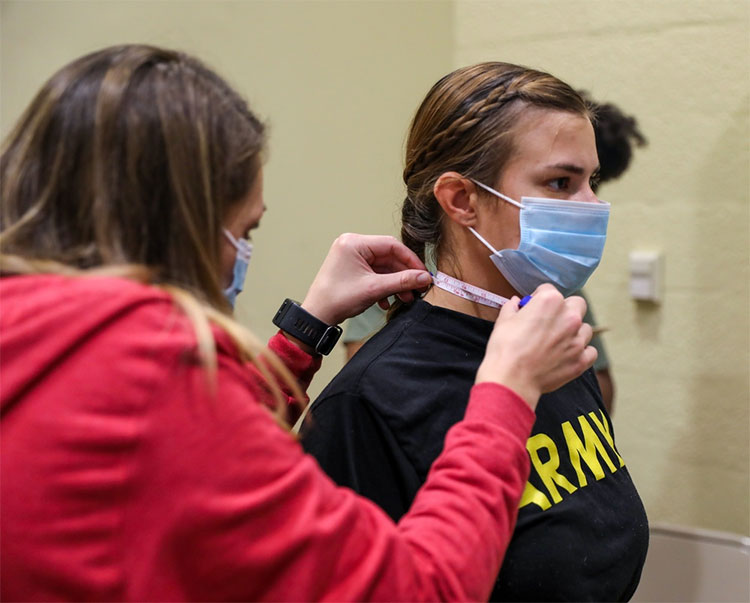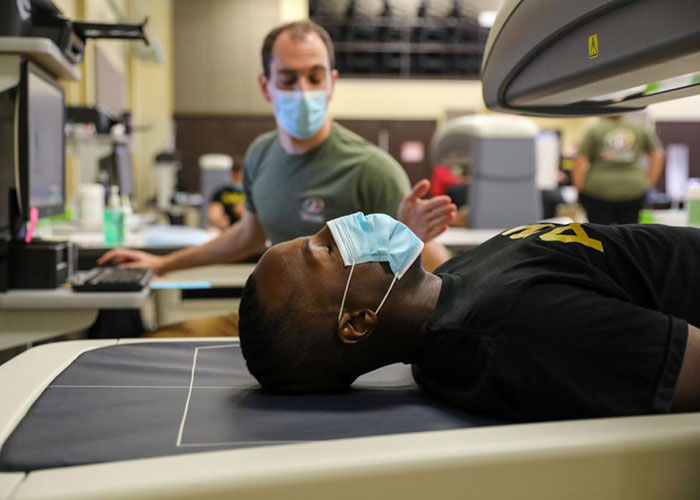The Science Behind the Army Comprehensive Body Composition Study: USARIEM completes critical data collection

The U.S. Army Research Institute of Environmental Medicine (USARIEM) cross-divisional team recently completed the U.S. Army Center for Initial Military Training (USACIMT)-directed Army Comprehensive Body Composition (ACBC) study. The ACBC is an Army-wide study of more than 2,690 Soldiers evaluating the effectiveness of the tape test and providing the scientific data and analysis to advise Army senior leaders to make data-driven decisions about the future of the Army Body Composition Program (ABCP). It has been roughly 20 years since the last time body composition equations have been evaluated and 10 years for body composition standards and Army Regulation 600-9. Even then, neither was the in-depth and diverse approach of the ACBC study.
Questions from Senior Leaders emerged about the link between fitness, health, and physical performance and the current methods used to measure body composition in the Army. In January 2021, USACIMT called upon USARIEM to provide answers.
"There were lots of questions about body composition and USACIMT saw us as subject matter experts and asked us to lead an Army-wide study to look at body composition," said Holly McClung, ACBC study lead and nutritional physiologist at USARIEM.
To do this, McClung collaborated with Dr. Kathryn "Katie" Taylor, director for USARIEM's Soldier, Performance, Health and Readiness (SPHERE) database and built a team of military, civilian, and contractor personnel across USARIEM. The team approached the task in two phases – Phase 1: an analysis of historical data using the SPHERE Database and Phase 2: a field study, to assess what the current Total Army Soldier population looked between 2021 and 2022.
Phase One – A look backward

"For the first phase, we wanted to look at a snapshot of what the Army looked like in the two years prior to the onset of the global pandemic," said Taylor. "We looked at body composition and performance on the [Army Physical Fitness Test], which was the test before the ACFT, and a series of other metrics. We looked at how all these outputs were impacted by a number of different demographic variables – sex, age, race/ethnicity, postpartum status among women and injury outcomes – to understand whether these variables effected body size measurements using body mass index."
Using the SPHERE database, a large repository with access to multiple administrative, medical and performance-based data sources currently collected by the Army, the team was able to collect the data needed to generate a retrospective look of body composition for each individual Soldier during the required timeframe. If a Soldier did not meet the height and weight requirements of ABCP, they then had their body fat estimated using the circumference-based tape method, for a final pass or fail measurement.
"The Army collects a ton of data on all its Soldiers so it allows us to take all that information and combine it so we can get a snapshot in time of each individual Soldier in the Army at any given period of time," said Taylor. "We were using unit recorded height and weight to calculate BMI to look at how body size/composition was impacted by all the different factors that we were interested in evaluating."
The results of this historical glimpse were presented to USACIMT leadership prior to moving on to the second phase – going out into the field.
Phase Two – Real-time field measurement
Data collection took place in four different locations over a period of nine months, placing participants in one of the forty categories that were identified. Categories were broken down by sex, age, and race/ethnicity. Once the specified number of participants per category was reached, the ACBC study team closed the category to new volunteers to avoid oversampling.
"What is really unique about the study is this is the first time, we really looked at a representative sample of the Total Army," said McClung. "We took the demographics from the Pentagon and then we stratified our study sample to figure out exactly what number of Soldiers we needed in each category. We knew, to the exact number, how we needed to recruit to fill all the demographic bins."
"We broke it down to these very tiny categories to ensure that we could say there was equal distribution across the different groups to what they represented in the Army," said Taylor.
The ACBC field study kicked off in October 2021 at Fort Bragg.

"For our first data collection, we really wanted to go out and just collect as much data as we could in 14 days, across all three compos – Active Duty, Reserves, and National Guard," explained McClung. "[Sgt. Maj. of the Army, Michael Grinston], came down to Fort Bragg, was a study participant and really got behind the study, which I think helped us have such a successful kick off to data collection at Fort Bragg."
Soldiers who volunteered to participate in the ACBC study had their body composition analyzed using the most modern technologies and techniques. This included DEXA body composition analysis, 3D total body scanning, and Bioelectrical Impedance Analysis (BIA). The team completed standard circumference-based taping in accordance with Army Regulation 600-9 to round out data collection.
"The Army will always need way to assess body size or composition that is field efficient. We know Soldiers represent a fit population and because of that we need to consider the relationship between muscle mass (and/or body fat) and physical performance. We have a strong data set from ACBC allowing us to break down body composition by sex, age, ethnicity, and race and feel confident in drawing a relationship between body composition and physical performance, say on the ACFT," said McClung.
"When it comes to body composition, our focus in the past has predominantly been on body fat percentage, with minimal focus on lean muscle mass," explains Taylor. "But lean muscle mass does play a key role in being a successful Soldier… If we could also incorporate performance, we might be able to capture some Soldiers who are capable of performing as a Soldier at the highest levels. And those are the individuals that the Army wants to make sure that they're not losing."
Another aspect of the ACBC study is the link between body composition and injury outcomes and performance.
"There are definitely those outlier Soldiers that perform very well and performance itself is protective against some of the health outcomes that the Army is interested in," said Taylor. "But we are trying to find a balance between ensuring that people have a healthy body composition that does not put them at higher risk for health outcomes like future injury but also accounts for those that may carry more muscle mass (body weight) and are good performers."
The Representative Sample
With the representative ACBC study population sample, USARIEM can make interpretations for the Total Army from the ACBC data collected. Data can be interpreted at an Army level for each of the demographic collection categories very similar to the technique used in the National Health and Nutrition Examination Survey research model.
"As researchers we had to work hard to ensure we collected data from each specific demographic group, or bin, so that we could make these interpretations. It was not as easy as showing up on an Army post and ask whoever is interested to volunteer and be measured as a participant– that would just be a convenience sample and could skew the interpretation of the outcomes to just those that were interested in getting their body measured," said McClung. "Having the strength in our study design allows us to extrapolate what outcomes would look like if we were able to collect data on each and every Soldier in the Army. To be honest, it was difficult to collect this data set and it was a lot of planning and work on the front end too, but well worth the outcome to provide Army Senior Leaders impactful output in real-time."
This representative sample could have been a complicated and difficult task, however, partnering with USACIMT made it much more manageable.
"We couldn't have done this study without them. USACIMT has the network across all Army installations, and they helped us narrow down locations based on what specific demographics were needed to complete our study sample. They knew where to lead us to find the Soldiers needed and in good numbers. This is why our team traveled to specific posts at certain times of the year, because USACIMT knew who was going to be at specific trainings at specific locations," McClung explains. "For instance, the National Guard. It would be really difficult for us to get a representative sample of the entire National Guard – we would have to go to almost every state to enroll Soldiers in the study, but if we went to Fort Lee at a specific time of the year, the National Guardsmen/women are there completing their training. So, we could get a national sample of however many hundred Soldiers that we needed in one swoop."
"When you look at our data, we have matched thee distributions across Military Occupational Specialties which was not our main goal, but when we started evaluating the data it matched almost perfectly with Total Army breakdown for physical demand categories (heavy, moderate, and low) that exist for the MOSs," said Taylor. "We were very happy with our sample, because we felt like we accurately captured all the different grouping of Soldiers, ensuring no Soldier felt like they were under-represented in our population."
The ACBC was a constantly evolving study. The data needs changed consistently as study demographic categories, or bins closed. Certain categories such as 18–20-year-old males, were easy to recruit for and therefore closed pretty quickly, whereas others were a little bit harder to recruit for. But in the end, the team got the job done.
Collecting this much data in this short time period was a challenge, but also a huge accomplishment.
"USARIEM is known for our field study expertise and our ability to take the show on the road," said McClung. "I think having that respect and rapport, not only with the instillations that we were going to, but with USACIMT and some of the Army Senior leaders really helped to put us on the map."
The Analysis of the Data
The USARIEM researchers provided the scientific analysis of the ACBC data to advise Army leaders and policy working groups to make science-based decisions on body composition and the health of the Soldier.
"With the ACBC data set we can look at how a 530 or 550 would impact Soldiers across the Army level and how that relates to ABCP flags, injuries, and health outcomes. This is what influenced the recommendation for a 540 ACFT score to exempt height and weight requirements. If we did not have the rich representative data, numbers in sex, age, ethnicity, and race, we would miss out on that type of interpretation and flexibility. We are able to look at how potential changes would impact the entire Army," said Taylor.
With the data collection complete and analyzed, McClung and Taylor have spent a good deal of time briefing Senior Leaders and discussing the outcomes. The duo serves as the scientific advisors to Army leaders, including, SMA Grinston and the Secretary of the Army, Christine Wormuth, as they inform on potential modernization of policy.
"Data-informed decisions are being made for the Soldier. Katie and I are asked to step up and explain the study outcomes, so we are involved in some of the working groups. We help clarify outcomes and impact but leave the policy recommendations to the rest of the team," said McClung. "We present the science in a nonbiased way."
As part of the working group, McClung and Taylor are in the room with Army senior leaders and ready to answer the scientific questions that allowing the working group to make fully informed decisions.
The Team
This study took teamwork to a whole new level. USARIEM's three divisions, Military Performance Division, Military Nutrition Division and Thermal and Mountain Medicine Division, worked together to staff each of the data collection trips. The ACBC team was nicely divided into military, civilian, and contractor personnel.
"It was pretty exciting for our entire team, especially the Soldiers because each and every one of them are touched by this work and future policy. The ABCP is real to them every six months," said McClung. "For the Soldiers, it really means a lot to be part of something that directly impacts them and their careers."
Depending on the study location and needs, the study team flexed from 20 to 30 USARIEM members. The days were long – on average 12 plus hours a day. The team would rotate in and out, taking turns pitching in where and when needed.
USARIEM may be the study leaders, but the team includes many more. USACIMT initiated the study, calling in USARIEM to lead the science. USACIMT was there every step of the way providing support, pre-briefing, being onsite during data collection and taking the lead with media. The site coordinators and support teams at each study location, Fort Lee, Fort Bragg and West Point, were critical to enabling data collection. Most importantly, the Soldier study participants were a huge part of the team – without them stepping up to volunteer, there would be no ACBC data to present or impact potential change.
"I feel like we couldn't have done it without each piece of the team. I'm so grateful for all that they did," said McClung. "We tried to make it fun."
A Task Well Done
On March 9th, Grinston announced significant changes to the Army Body Composition regulation. These changes are a direct result of the research conducted by McClung, Taylor and the USARIEM team. The ability to improve the lives of Soldiers through high quality research is a strength of USARIEM and a reflection of the commitment exhibited by their scientists. This success is being recognized by Army Senior Leaders up to the Secretary of the Army. For the "dynamic duo," as Wormuth, called McClung and Taylor, it is a career accomplishment they will never forget.
"It is," agreed McClung. "To have your science put into policy that's forward moving and impacts the entire Army, it's mind blowing. I feel like I'm just trying to ride the wave."
USARIEM is a subordinate command of the U.S. Army Medical Research and Development Command under the Army Futures Command. USARIEM is internationally recognized as the DOD's premier laboratory for Warfighter health and performance research and focuses on environmental medicine, physiology, physical and cognitive performance, and nutrition research. Located at the Natick Soldier Systems Center in Natick, Massachusetts, USARIEM's mission is to optimize Warfighter health and performance through medical research.













